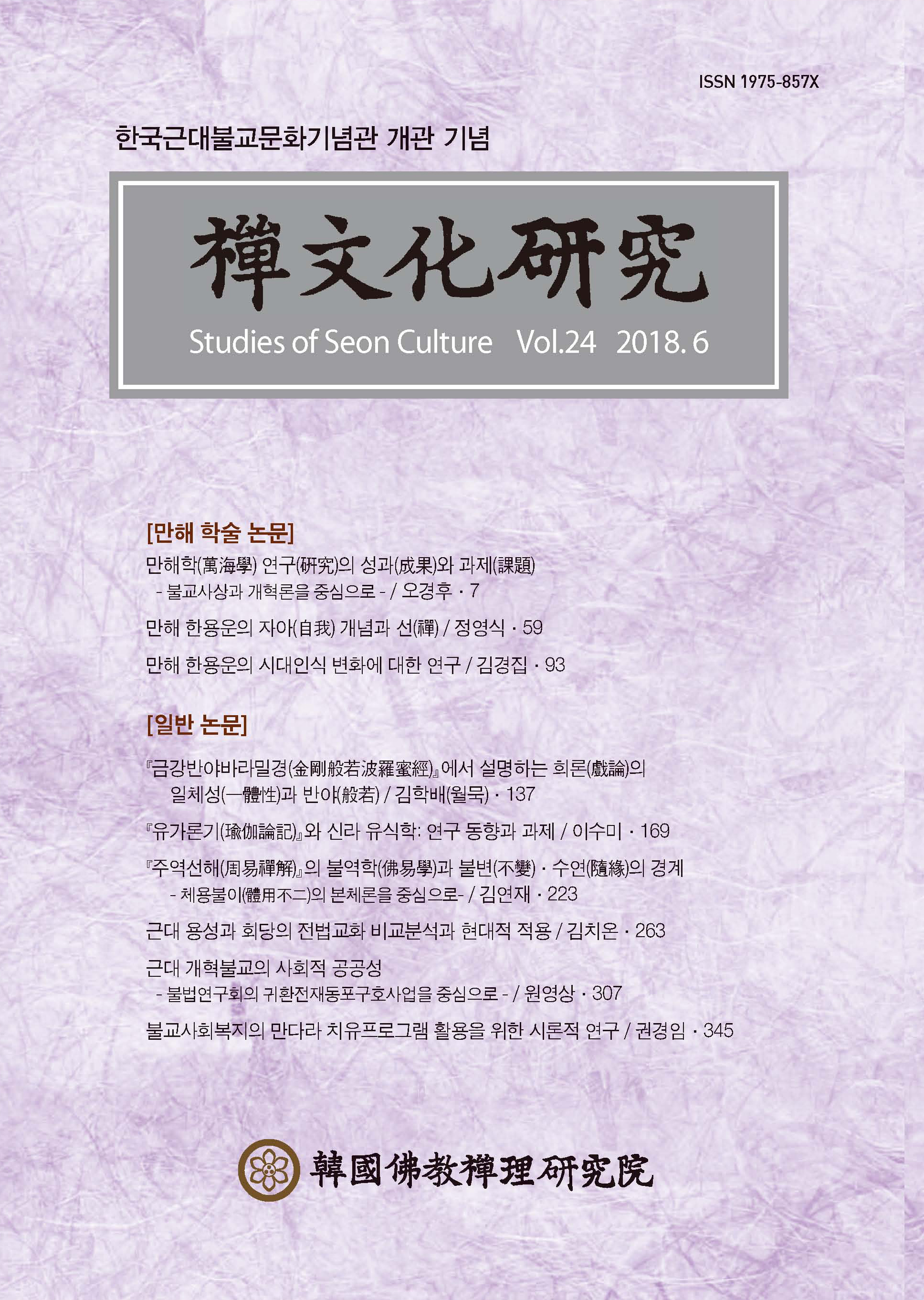희론은 일반적으로 무익한 말 또는 허망분별로 설명한다. 희론의 구조는 서로 모순되거나 대립관계에 있는데, 경전이나 논서에서는 이러한 관계를 매개로 하여 진리를 들어낸다. 『금강반야바라밀경(金剛般若波羅蜜經)』에서도 희론을 통하여 반야(般若), 공(空) 등의 진리를 설명한다. 그 희론은 ‘A卽非A’와 ‘A卽非A, 是名A’ 인데, 이 두 형식에서 A와 非A는 모순관계에 있다. 이 모순된 형식과 관련하여 선행연구는 많이 있지만, 여기서 논의할 선행연구는 초기 유식과 중관학의 관점으로 한정한다. 초기 유식과 중관학에서 모순관계를 설명하는 희론은 ‘亦有亦無’로 표현은 같지만, 드러나는 진리를 설명방법은 서로 다르다.
초기 유식의 논서에서 A와 非A는 서로 다른 시간에 존재하지만, 일체의 관계로 본다. A와 非A가 같다는 관점에서 일체로 보는 것은 아니다. 공, 무상, 분별하지 않는 인식작용 등의 공통된 관점에서 일체로 본다. 반면에 중관에서는 A와 非A는 동시에 존재하고, 불가분의 관계이다. 진리가 드러나는 것은 A와 非A의 모순이 논파되는 것과 동시에 드러나는 파사현정의 논리로 설명한다. 그러나 타떼가와 무사시(立川武藏)는 희론에는 모순이 없다고 하고, 희론을 형식논리에 따라 해석한다. 그 결과 『금강반야바라밀경』의 희론에는 반야의 논리는 드러나지 않는다고 한다.
스즈키 다이세츠(鈴木大拙)는 ‘A卽非A, 是名A’에 대하여 즉비논리라고 이름하고, 여기서 반야가 드러나는 것을 초기 유식 관점에서 설명한다. 그러나 선행연구 중에는 ‘A卽非A, 是名A’를 긍정, 부정, 다시 긍정하는 순서에 따라 개별적으로 해석하는 경우가 있다. 이것은 스즈키의 견해와 다르다. 스즈키는 ‘A卽非A’에서 A와 非A는 일체의 관계를 형성하고, ‘A卽非A’와 ‘是名A’의 관계는 동등한 것으로 설명한다.
‘A卽非A, 是名A’에 대하여 『중론』의 삼제(三諦)에 맞추어 설명한 견해도 있다. 그것은 A, 非A, 是名A를 가(假), 공(空), 중(中)에 따라 맞춘 설명이다. 하지만 대부분 『중론』에서 드러나는 진리는 ‘A卽非A’의 형식에서 파사현정의 논리에 따라 설명한다. 즉 ‘A卽非A’에서는 진리를 직접 설명하지 않는다. 또한 진리에 대한 표현도 ‘A卽非A, 是名A’에서 ‘是名A’처럼 A나 非A와 관련된 구체적으로 제한되지 않는다. 따라서 ‘A卽非A, 是名A’를 파사현정의 논리로 설명하는 것은 부적합하다. 만약 ‘是名A’를 진리에 대한 설명으로 보게 된다면, 파사현정에서 드러나는 진리와 ‘是名A’에서 드러나는 의미가 중복된다. 그러므로 ‘A卽非A, 是名A’보다는 ‘A卽非A’가 『중론』의 논리로 설명하기에 적합하다. 반면에 초기 유식의 관점에서는 ‘A卽非A’와 ‘A卽非A, 是名A’ 모두에 설명할 수 있다. 이것은 A와 非A의 모순을 설명하는 방법에 따른 차이로 보인다. 이러한 차이점에서 본다면, 『금강반야바라밀경』의 희론은 중관학보다는 초기 유식의 관점이 잘 적용된다.
Desana(戱論) is generally described as a useless word or vain discrimination. The structure is a contradiction or an antagonistic relationship. It is also revealed the truth by means of this relationship in Sutra or sastra. In the same way the vajracchedika - parajnaparamita - sutra (『金剛般若波羅蜜經』) also explains the truth of prajna(般若), sunya(空), etc. Desana in the form of expression has ‘A is not - A’ and ‘A is not - A, its name is A’, and here ‘A’ and ‘not - A’ are in a contradiction.
In the early Vijnaptimatrata(初期唯識) and Madhyamaka Studies(中觀學), desana considers ‘both being and beingless(亦有亦無)’ which is explaining a contradiction is expressed as in the same way, the method of explaining the revealed truth is different. In sastra of the early Vijnaptimatrata, ‘A’ and ‘not - A’ exist at different times, but they see as relations of ‘a single substance(一體)’, and is looked on it from a common point of view, such as sunya(空) or an undiscerning cognitive action. Logic of A = not - A(卽非論理) is also explained from this point of view.
On the other hand, in Madhyamaka Studies ‘A’ and ‘not-A’ exist at the same time and is inseparable. Truth is explained as a logic of ‘refuting false and disclosing the correct(破邪顯正)’, which is when the contradiction between ‘A’ and ‘not - A’ is broken truth is come out at the same time.
According to the formal logic in Madhyamaka - sastra(『中論』), Tatekawa Musashi (立川武藏) interprets the theory and he said that the logic of prajna is not revealed in prapanca(戱論) of the vajracchedika - parajnaparamita - sutra.
There are views which are matched with a threefold truth(三諦) of Madhyamaka - sastra about ‘A is not - A, its name is A.’ However, the truth of Madhyamaka - sastra is explained in the form of ‘A is not - A’ according to the logic of ‘refuting false and disclosing the correct’, and the term ‘its name is A’ is unnecessary. Truth is not relevant to this expression of ‘A’ or ‘not - A.’
Therefore, ‘A is not - A, its name is A’ is not suitable for explaining with the logic of Madhyamaka - sastra. On the other hand, in a standpoint of the early Vijnaptimatrata, ‘A is not - A’ and ‘A is not - A, its name is A’ can be explained. This is seen as a difference between ‘A’ and ‘not - A’ methods of explaining a contradiction.




